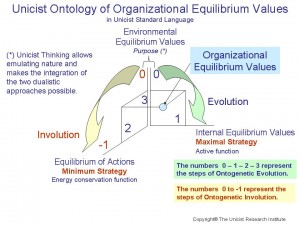Organizational equilibrium is defined by the values of organizations. A business strategy needs to end with an organizational design that basically has to integrate the business processes defining the centrifugal forces of the company in order to expand and the centripetal forces in order to generate profits and grow as an organization.
 Organizational equilibrium is the integration of the equilibrium with the environment and the internal equilibrium of organizations.
Organizational equilibrium is the integration of the equilibrium with the environment and the internal equilibrium of organizations.
The apparent paradox is given by the fact that actions are the energy conservation function for organizational equilibrium. Therefore it is implicit that inaction destroys organizational equilibrium and, if generalized, produces the destruction of an organization.
The driver of organizational equilibrium is the environmental adaptation that needs to be defined according to the stage and positioning of an organization.
When the organization needs to expand a centrifugal disequilibrium needs to be designed. When an organization needs to generate profits a centripetal disequilibrium needs to be defined.
These situations need to be designed and adequately complemented in order to ensure results.
Consequences of the use of organizational equilibrium:
1) Organizational strategy is materialized in the design and management of the necessary organizational equilibrium.
2) The generation of energy and its flow requires implicitly the existence of disequilibrium.
3) Centrifugal and centripetal functions of organizations need to be integrated to generate organizational equilibrium.
4) Start up organizations cannot start being equilibrated. Equilibration is the consequence of maturity.
5) Involving organizations are naturally centripetal.
6) Inaction destroys organizational equilibrium
7) Growth requires generating centrifugal actions in the environment to generate the necessary added value to be able to develop a maximal strategy and having the funding of the shareholders to sustain these actions.
8) ROI thinking is basic to be able to manage organizational equilibrium.
9) Institutions need to manage organizational equilibrium. Short term projects do not need to be equilibrated.
10) Entrepreneurial organizations need equilibrium if they have long term objectives.
Access or request a Unicist Tweetinar on this subject at: http://www.academic.unicist.org/unicist_tweetinars.shtml
Learn more about the trend of ontology based solutions for businesses: http://www.unicist.net/obs.shtml
